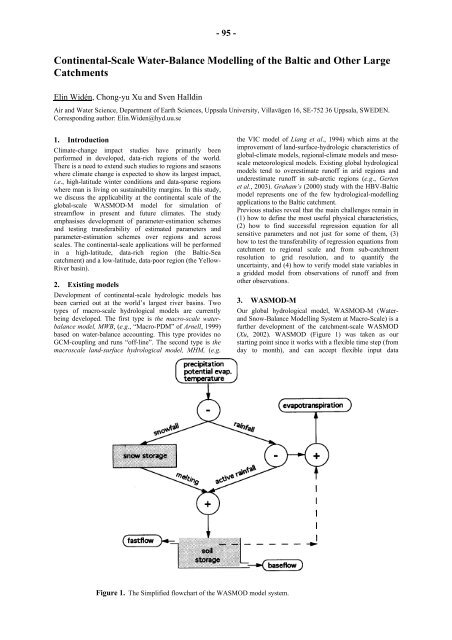Fourth Study Conference on BALTEX Scala Cinema Gudhjem
Fourth Study Conference on BALTEX Scala Cinema Gudhjem
Fourth Study Conference on BALTEX Scala Cinema Gudhjem
You also want an ePaper? Increase the reach of your titles
YUMPU automatically turns print PDFs into web optimized ePapers that Google loves.
- 95 -<br />
C<strong>on</strong>tinental-Scale Water-Balance Modelling of the Baltic and Other Large<br />
Catchments<br />
Elin Widén, Ch<strong>on</strong>g-yu Xu and Sven Halldin<br />
Air and Water Science, Department of Earth Sciences, Uppsala University, Villavägen 16, SE-752 36 Uppsala, SWEDEN.<br />
Corresp<strong>on</strong>ding author: Elin.Widen@hyd.uu.se<br />
1. Introducti<strong>on</strong><br />
Climate-change impact studies have primarily been<br />
performed in developed, data-rich regi<strong>on</strong>s of the world.<br />
There is a need to extend such studies to regi<strong>on</strong>s and seas<strong>on</strong>s<br />
where climate change is expected to show its largest impact,<br />
i.e., high-latitude winter c<strong>on</strong>diti<strong>on</strong>s and data-sparse regi<strong>on</strong>s<br />
where man is living <strong>on</strong> sustainability margins. In this study,<br />
we discuss the applicability at the c<strong>on</strong>tinental scale of the<br />
global-scale WASMOD-M model for simulati<strong>on</strong> of<br />
streamflow in present and future climates. The study<br />
emphasises development of parameter-estimati<strong>on</strong> schemes<br />
and testing transferability of estimated parameters and<br />
parameter-estimati<strong>on</strong> schemes over regi<strong>on</strong>s and across<br />
scales. The c<strong>on</strong>tinental-scale applicati<strong>on</strong>s will be performed<br />
in a high-latitude, data-rich regi<strong>on</strong> (the Baltic-Sea<br />
catchment) and a low-latitude, data-poor regi<strong>on</strong> (the Yellow-<br />
River basin).<br />
2. Existing models<br />
Development of c<strong>on</strong>tinental-scale hydrologic models has<br />
been carried out at the world’s largest river basins. Two<br />
types of macro-scale hydrological models are currently<br />
being developed. The first type is the macro-scale waterbalance<br />
model, MWB, (e.g., “Macro-PDM” of Arnell, 1999)<br />
based <strong>on</strong> water-balance accounting. This type provides no<br />
GCM-coupling and runs “off-line”. The sec<strong>on</strong>d type is the<br />
macroscale land-surface hydrological model, MHM, (e.g.<br />
Figure 1. The Simplified flowchart of the WASMOD model system.<br />
the VIC model of Liang et al., 1994) which aims at the<br />
improvement of land-surface-hydrologic characteristics of<br />
global-climate models, regi<strong>on</strong>al-climate models and mesoscale<br />
meteorological models. Existing global hydrological<br />
models tend to overestimate runoff in arid regi<strong>on</strong>s and<br />
underestimate runoff in sub-arctic regi<strong>on</strong>s (e.g., Gerten<br />
et al., 2003). Graham’s (2000) study with the HBV-Baltic<br />
model represents <strong>on</strong>e of the few hydrological-modelling<br />
applicati<strong>on</strong>s to the Baltic catchment.<br />
Previous studies reveal that the main challenges remain in<br />
(1) how to define the most useful physical characteristics,<br />
(2) how to find successful regressi<strong>on</strong> equati<strong>on</strong> for all<br />
sensitive parameters and not just for some of them, (3)<br />
how to test the transferability of regressi<strong>on</strong> equati<strong>on</strong>s from<br />
catchment to regi<strong>on</strong>al scale and from sub-catchment<br />
resoluti<strong>on</strong> to grid resoluti<strong>on</strong>, and to quantify the<br />
uncertainty, and (4) how to verify model state variables in<br />
a gridded model from observati<strong>on</strong>s of runoff and from<br />
other observati<strong>on</strong>s.<br />
3. WASMOD-M<br />
Our global hydrological model, WASMOD-M (Waterand<br />
Snow-Balance Modelling System at Macro-Scale) is a<br />
further development of the catchment-scale WASMOD<br />
(Xu, 2002). WASMOD (Figure 1) was taken as our<br />
starting point since it works with a flexible time step (from<br />
day to m<strong>on</strong>th), and can accept flexible input data













